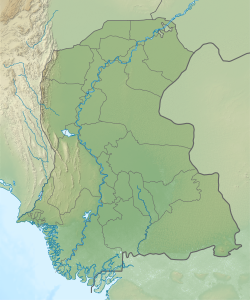Luari Sharif Luari, Lowari | |
|---|---|
 | |
| Coordinates: 24°33′42″N68°54′07″E / 24.561745°N 68.902034°E [1] | |
| Country | Pakistan |
| Region | Sindh |
| District | Badin |
| Population (2017) [2] | |
• Total | 9,527 |
| Time zone | UTC+5 (PST) |
| • Summer (DST) | UTC+6 (PDT) |
Luari Sharif, also spelled Lowari, [1] is a town and union council [3] in Shaheed Fazil Rahu taluka of Badin District, Sindh. [4] As of 2017, it has a population of 9,527, in 1,907 households. [2] It is the site of the shrine of Hazrat Khawaja Muhammad Zaman, one of the most revered religious figures in Sindh. [5] The shrine, among the oldest in Sindh, was closed for 37 years due to a custodianship dispute before being reopened in January 2020. [5] This hindered renovation and maintenance of the shrine, which it especially needed after suffering substantial damage during the 2011 Sindh floods. [5] A 2015 attempt by the Auqaf department had been cancelled after tension escalated between the two rival groups, leading to one person being shot and killed. [5] The successful 2020 reopening of the shrine took place without incident, with law enforcement officers on standby, and Auqaf Secretary Munawwar Mahesar unlocked the shrine's main entrance. [5] The shrine is open to women in the mornings and to men in the evenings. [5]

